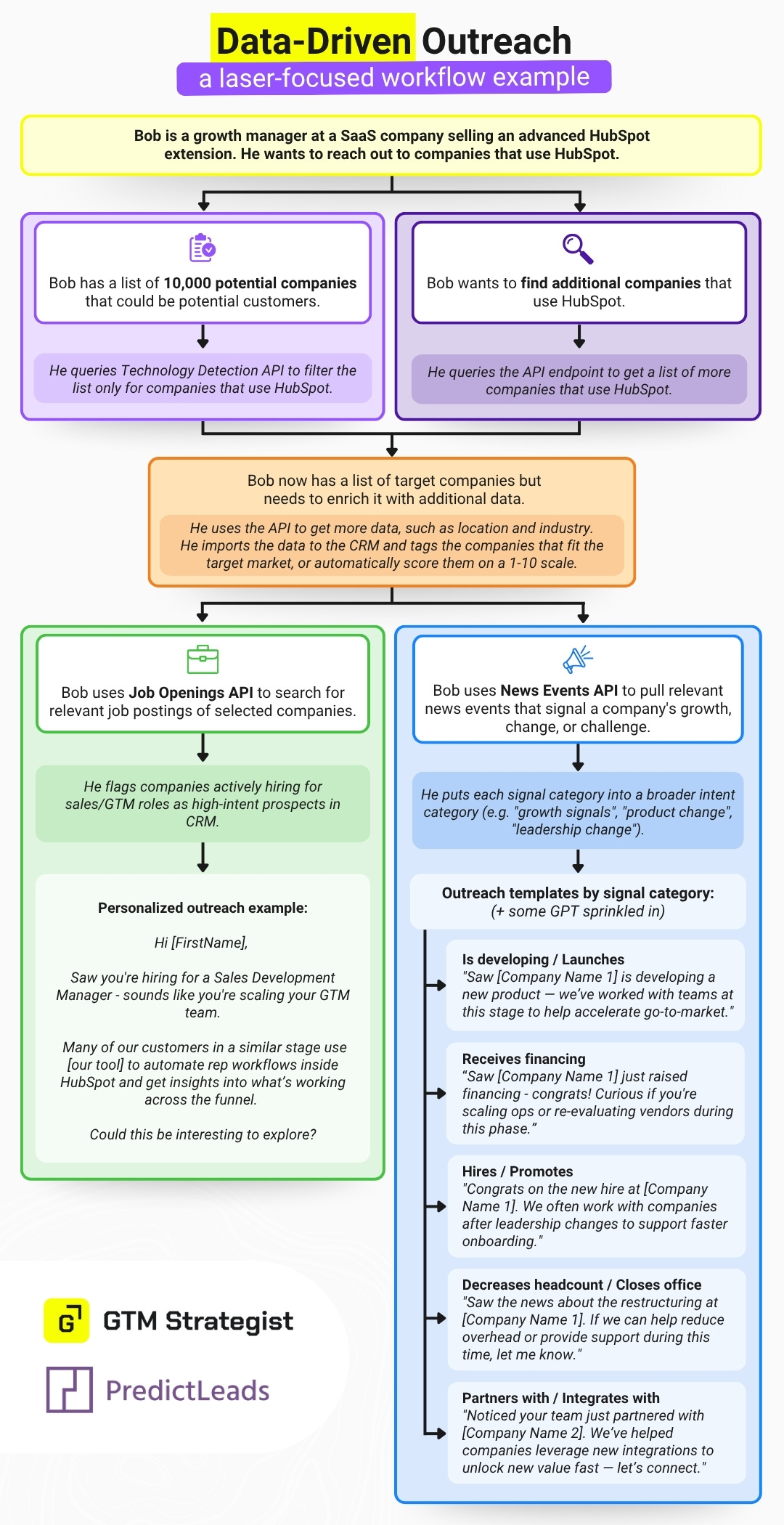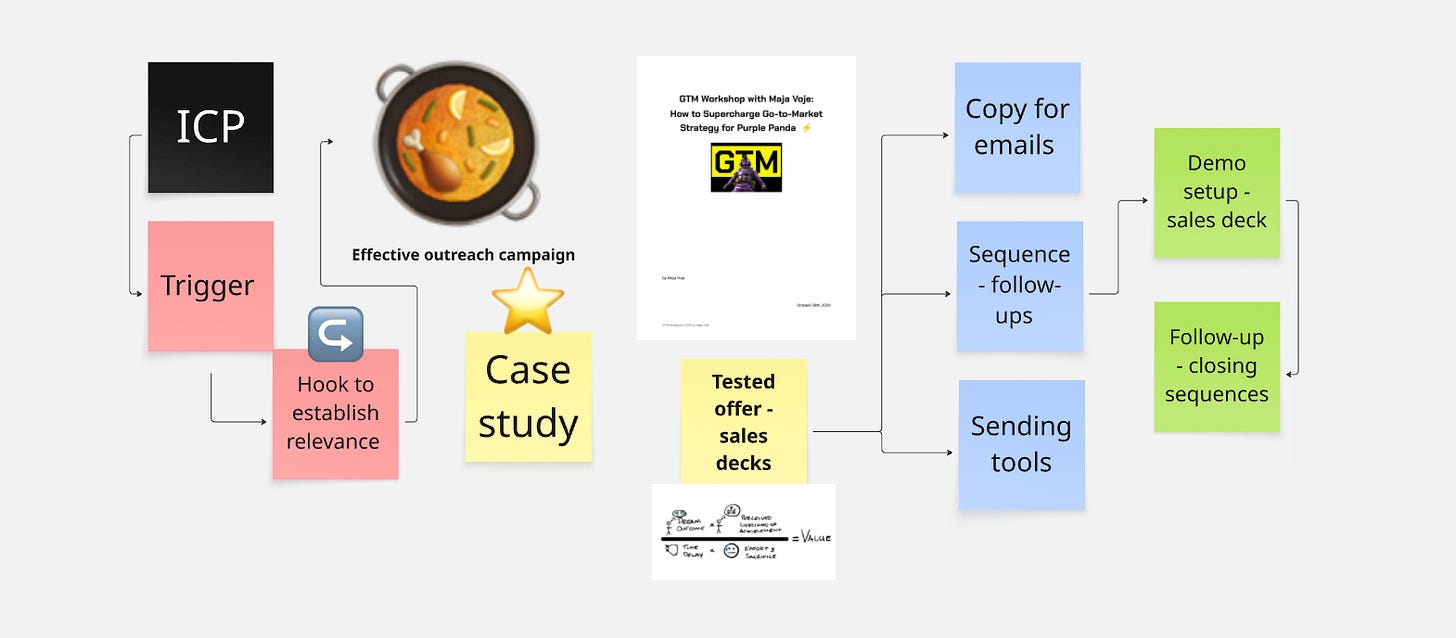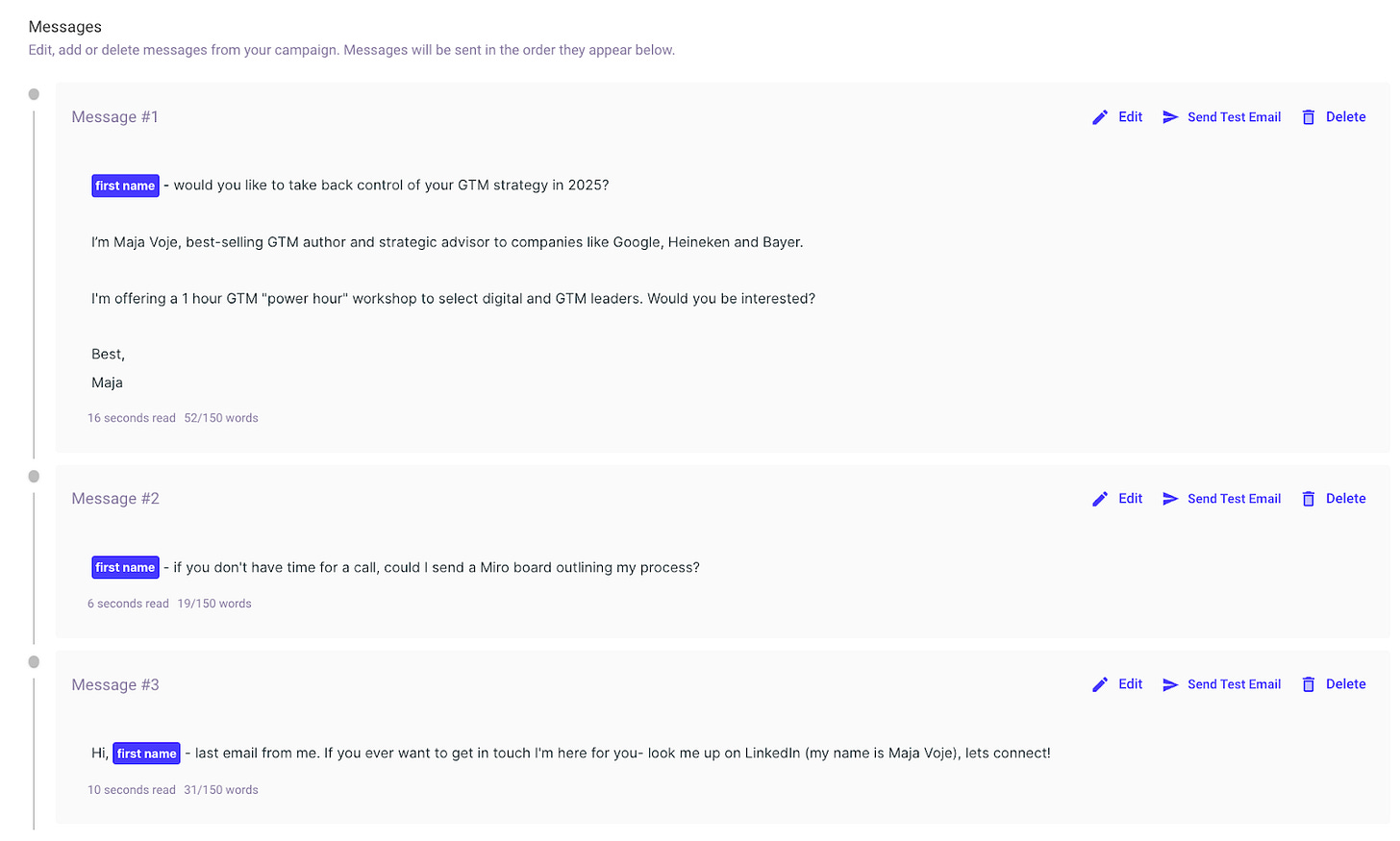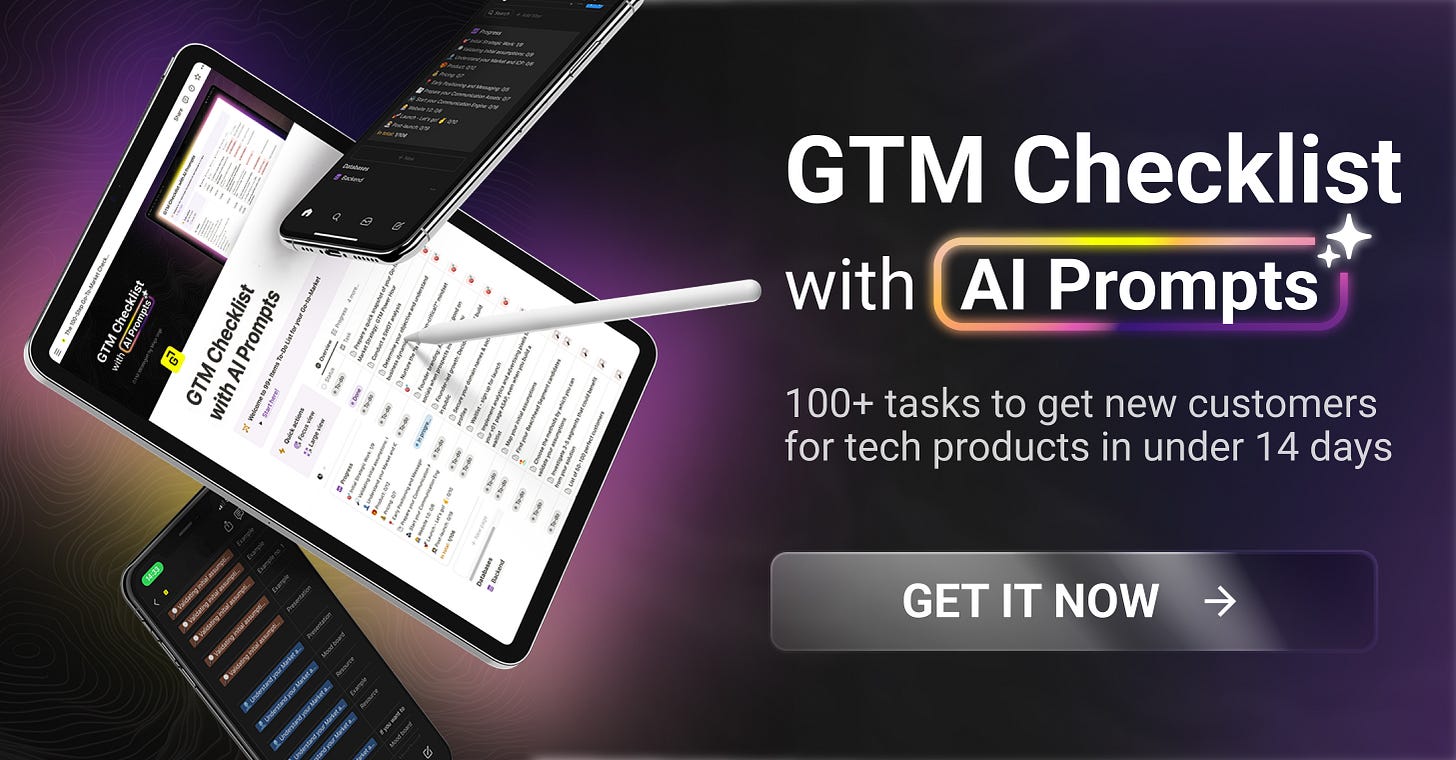The GTM Outreach Playbook: From Triggers to Demos
Here's the full system, templates, and real examples from a database of 92 million companies
Dear GTM Strategist!
In June, I trained 35 startup teams.
31 of them were already doing some form of outreach.
That beautiful, proactive approach where you don’t sit around waiting for leads to magically appear. You go out and create opportunities.
But here’s the kicker:
Most of these teams were making obvious, preventable mistakes. Some were just pitch-slapping strangers. Few had a structured outreach campaign or even knew who their ideal customer was.
Meanwhile, they were burning resources on content and conferences when they were probably just 50 focused emails away from landing their next breakthrough client.
Outreach isn’t a numbers game.
It’s a relevance game.
I wrote this guide in the hope of helping you navigate a battle-tested system for transitioning from "just reaching out" to "booking qualified demos." And I was not alone on this mission - PredictLeads pitched in with templates and triggers based on their 92 million companies database.
Let’s get some ICP-fit demos, people!
Unleash the power of outreach. 💪
This post is sponsored by Momentum - an enterprise listening platform for revenue teams that uses advanced AI agents to transform your customer conversations— emails, calls, support tickets—into actionable insights for revenue success.
Most GTM teams are sitting on a goldmine of CRM data, but 90% of it is fragmented, outdated, or invisible to AI. The AEIOU Framework by Momentum is how leading GTM teams fix that.
Get the 56-page AEIOU Framework white paper with examples of AI agents that actually drive revenue.
Explore the white paper by talking to the AI agent (ask it: "Can you give me a high-level walk-through of this research report?") here.
Or download the full report here:
Outreach is like a stew - it needs multiple ingredients
This is where I like to start when teams are working on their first structure's outreach campaign:
“If you spray and pray, you’ll get your domain blacklisted, burn some bridges and get blocked from LinkedIn.”
C’mon, just kidding - I am not a monster.
But I have to be realistic, too. Many founders waste months on “thought leadership”, “networking” at conferences, and writing long LinkedIn posts that never lead to real business.
I tell them outreach still crushes it - it’s one of the fastest, highest-ROI GTM channels out there. But it only works if you do it right.
In a world flooded with lazy, AI-written spam, we have to do better. And then I give them this recipe:
On your outreach journey, you’ll need to nail:
Your Ideal Customer Profile (ICP) - or a set of them to test (more advanced)
Knowledge of triggers - what would make someone interested in buying
Hook to establish the relevance - what is the problem of my ICP, what do I offer, and why should they care about this now (what’s in it for them)
Case study, video, or a knowledge resource
A tested offer and sales decks
Copy for emails (multiple-touch sequences)
Tech stack to send this at mass
Plan for your demo and follow-up sales process.
That’s it.
Nobody will blame you for starting manually by listing 50 people that fit your ICP hypothesis and craft highly personalized emails to engage them and get them to a demo.
But eventually, you’ll run out of personal contacts, get diminishing returns, and will have to learn how to do this at scale regardless.
Relevance is sending the right message to the right person at the right time.
And today, technology can help us be “shut up and gimme your booking link” level relevant.
Let me show you how.
🎯 Outreach only works when you know who you’re talking to
Start with clarity. Your outreach is only as good as your ICP.
One of the founders I work with sent out 3000 messages on LinkedIn and booked 6 meetings.
Is that good or bad?
Well, if those meetings converted, it would be great - but they did not.
Outreach wasn’t converting - not because of the message, but because he was targeting the wrong audience. Those who did not care about the product had questionable willingness to pay and happily moved on with their lives after seeing his message.
He defined ICP as:
SaaS companies with $5–10M ARR
2–5 years old
Based in the US and Canada
Decision maker: Head of Growth
And that is too vague. There are ~13,500 companies that he could potentially target and the attempt of the message was something down the line:
“Hi, I see you lead growth at [company name] - did you see organic reach dropping? I have - and we solved that for X companies including Y that increased their sales in 30 days by ZZ%. Wanna hear more?”.
I mean, it's not the worst thing I’ve ever gotten. But he can do much better. How?
Use trigger events to find warm leads - and reel them in 🪝
Instead of mass-sending to 13,000 addresses, we asked ourselves a question: how can we recognize from their externally detectable behaviors that someone would be interested in that AI GTM solution?
Here are some of the ballpark ideas:
They gave a testimonial to a competitor
They just hired a new GTM lead
Is actively searching for 10 AI-related roles
They raised a funding round
Each of these is a trigger to start a contextual, relevant conversation.
Example message:
"Congrats on the Series A and hiring a new RevOps lead! We help SaaS teams like [Competitor X] streamline onboarding during growth spikes. Want me to show you how it works?"
Could we do better? Sure! How could I resist this: 😍
But we work with what we have.
To help you find the best triggers for your outreach, I asked PredictLeads to put together a mega list of triggers exclusively for readers of my newsletter - and they delivered.
PredictLeads is a global data provider trusted by companies like Clay, Copy ai, Dealroom, and Lavender. Their focus? Daily crawling real-time business signals (like hiring sprees, funding rounds, product launches, tech stack changes, website revamps…) from over 92 million companies to help GTM teams act when the timing is just right.
You can plug these signals directly into tools like Clay or use their API to fuel custom prioritization, personalization, and scoring models.
They’ve made the trigger list completely free - plus you’ll find real outreach hook examples inside.
And they also prepared an overview of a data-driven outreach strategy:

Study the spreadsheet (thanks PredictLeads ♥️) and if you have a serious outreach use case that needs more advanced data structures, such as this one, give them a try. They offer 100 free credits a month, but if you’d like to give it a thorough try, contact them, tell them you learned about them through GTM Strategist - and you will get 1000 FREE credits.
From hello to demo: Crafting an outreach sequence that converts
No idea why so many people still make this mistake 🤷: They treat outreach as “one shot, one opportunity” and fill their intro outreach message with everything (who they are, how many years in the business, 2 case studies, link to the demo call 💥- pitch slap).
Huge no! You need to initiate a conversation and add value. The first message is intended to pique their interest and continue the conversation. Typically, we use 3-7 messages in an outreach sequence. Here’s what an effective sequence includes:
Message 1 – Trigger + Hook (why them + why now)
Message 2 – Value drop (case study, insight, or Loom video)
Message 3 – Follow-up with a call to action ("worth a look?")
Keep each message short, relevant, and written like a human.
Do not send demo links in the first message - it's brute and a shortcut to spam reports.
If all this sounds too complex, let me set up more realistic standards:
Level 1: Manual & Hyper-personal
1:1 messages to 50-100 hand-picked leads
Goal: Validate triggers, hooks, and ICP
Example: A founder that I worked with tested 2 ICPs - a technical founder SaaS and a founder of ecomm, Europe, min $1 million ARR. He put together a list of his contacts from network, we worked on an outreach message, and out of 50 people contacted, he booked 20 demos. We got a clear insight that one of these ICPs will not work because people do not understand the product and see value in it.
Level 2: Semi-Automated
Use a tool like Instantly (email) and Heyreach (LinkedIn) to scale sending, still with contextual inserts
Goal: 1000–2000 contacts
Example: A team of co-founders that I work with sent out 1000 LinkedIn invites to hard-to-reach ICP (no text), approximately 100 connection requests were approved, and they booked six enterprise demos from this campaign. We expect one deal to close.
Level 3: Engine Mode
Refined ICP + message + proof = scalable outbound engine
Combine with retargeting and inbound for max compounding
Example: A company I work with went through stages 1 and 2 in Q2, and now we’re orchestrating outbound as a full GTM motion - building a data and tech stack with Clay to generate a steady flow of high-fit leads. We're layering in AI-assisted workflows for mass-personalization and light ABM to create multi-touchpoint campaigns across email and LinkedIn, making every message count.
Level 4 - AI SDRs? 🤠
Maybe …
But let’s first make some money from the stage that we are currently on.
Outreach isn’t about being louder.
It’s about being specific enough to matter.
Hope this was helpful and worth your time and attention.
Really study those triggers - it will open up your mind from “bother strangers” to “adding value to the ICP. I know outreach is not specifically enjoyable for most of us - but we can get better at it; it is just another muscle to train and grow.
As I like to say to my folks:
“What is the worst thing that can happen? Someone can block you, send you a nasty message back, or think that you are annoying. Can you live with it?”
Yes, if the high is worth the pain. So get ready to send those 50 emails that are separating you from the next deal you close ✌️
📘 New to GTM? Learn fundamentals. Get my best-selling GTM Strategist book that helped 9,500+ companies to go to market with confidence - frameworks and online course included.
✅ Need ready-to-use GTM assets and AI prompts? Get the 100-Step GTM Checklist with proven website templates, sales decks, landing pages, outbound sequences, LinkedIn post frameworks, email sequences, and 20+ workshops you can immediately run with your team.
🏅 Are you in charge of GTM and responsible for leading others? Grab the GTM Masterclass (6 hours of training, end-to-end GTM explained on examples, guided workshops) to get your team up and running in no time.
🤝 Want to work together? ⏩ Check out the options and let me know how we can join forces.









